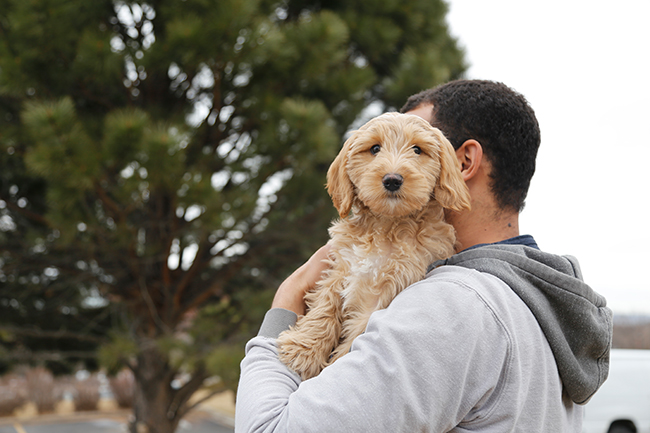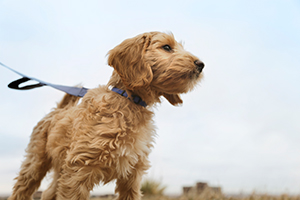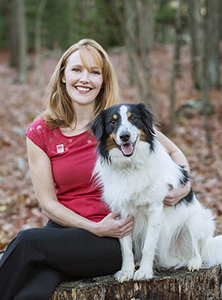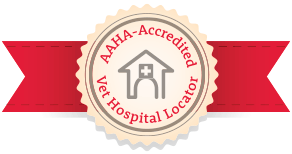Is the “Designer Dog” the New Pedigree?

By Dr. Heather Loenser
New York is the quintessential melting pot; not just for us, but for our pets, too. From pit bulls to Pomeranians and bulldogs to boxers, virtually every breed calls New York home. We’re talking pure breeds, mixed breeds, and the ever-growing population of “designer dogs”. As a veterinarian, I see more and more of these hybrids visiting my practice, from the itty bitty teacup “Cheeks” (Chihuahua/Pekingese mix) to the larger-than-life Great Pyredane (Great Dane/Great Pyrenees mix).
So, what’s up with these designer dogs and why are they so desirable? Ask any owner of a designer dog, and you’ll get an answer something like this: “We wanted a cocker spaniel, but it sheds. So we got a cockapoo and that solved the problem.” And that, in fact, is exactly why the designer dog was created: to fill a need. Take, for example, the Labradoodle. In the 1980s, Wally Conron, the breeding manager for the Royal Guide Dog Association of Australia, was inundated with requests for hypoallergenic guide dogs. He thought the standard poodle would be perfect because it doesn’t shed and is very intelligent. However, after working with them for a few years, he discovered that they didn’t have what it takes to be great guide dogs. He then had a brainstorm: Why not cross the poodle with a Labrador retriever, a breed already established as a reliable guide dog? And the Labradoodle was born. Unfortunately, the hybrid didn’t work either because not all of Wally’s Labradoodles came out the same; some were not hypoallergenic. Only when you mix two pure breeds over a long period of time will you get predictable offspring. This is true for the cockapoo (cocker spaniel/poodle), the goldendoodle (golden retriever/poodle), the Maltipoo (Maltese/poodle), the Schnoodle (Schnauzer/poodle) and a myriad of other designer dogs.
 Line up 50 pure breed Chesapeake Bay retrievers and you’d be hard pressed to see much of a difference. Line up 50 goldendoodles and you’d see a variety of sizes, coats, and temperaments.
Line up 50 pure breed Chesapeake Bay retrievers and you’d be hard pressed to see much of a difference. Line up 50 goldendoodles and you’d see a variety of sizes, coats, and temperaments.Take the case of upper westsider Rosemary who fell in love with a friend’s very small, well-behaved goldendoodle. She made it her mission to adopt one just like it and found the perfect pup in Florida. After multiple conversations with the breeder, the doodle was flown to JFK into Rosemary’s waiting arms. But the pup was not like her friend’s at all: he was larger, much more rambunctious and, horror of all horrors, he shed all over the place! Yes, he was a goldendoodle, but apparently he had way more “golden” than “doodle.” After investing in a new vacuum cleaner and a few obedience classes, the new dog settled in beautifully. Thankfully, no one in the family had allergies, or Rosemary would have had a big problem.
The lesson here? Before you say “yes” to the pet, meet him in person. Since the characteristics of designer dogs vary, it’s important to spend time with the dog and to ask pertinent questions to whoever’s caring for him. Rosemary would have benefited from asking the breeder the following questions:
Which of the two breeds presents itself more?
Knowing he was more “golden” would have alerted her to the fact that he might be a shedder. Sometimes the quality you want to eliminate in the mix will still be prevalent if the dog is more of one breed than the other. For example, a puggle (pug/beagle) might still be a howler if he’s more beagle than pug.
How big will he be?
Had Rosemary asked how many pounds the dog’s parents were, she would have been able to gauge her dog’s adult weight. Many pet owners have watched in amazement as their so-called “mini” labradoodles rocket to 50 pounds.
What is his activity level?
Because Rosemary’s dog was large and much more energetic than she anticipated, he was like a bull in a china shop in her small apartment. Had she asked about his energy level, she might have chosen a different dog.
Adopt from a breed rescue organization
A little-known fact is that there are rescue organizations for most breeds including designer dogs. If you Google “Maltipoo rescue”, you’ll see what I mean. What’s invaluable is that many of these rescue groups have go-to foster families who care for the dogs until their forever homes are found. This affords the foster parents opportunities to screen the dogs for stress or aggression as they interact with family pets and kids. The foster families get to know the dogs well, which is very helpful to prospective pet parents who are eager to learn everything they can about their new dog. Ultimately, foster parents can act as matchmakers, helping you decide if the pet is the perfect fit for your family.
Purchase from a Reputable Breeder
Not only can the characteristics of designer dogs vary wildly, the dedication of the people who breed them can, too. Some care about money above all else, while others are dedicated to providing families with healthy, happy dogs. What you don’t want to do is accidentally support “puppy mills”, which house the breeding dogs in cages and remove their puppies at a very young age. These pups are then sold to pet stores or through online brokers. To avoid this, visit the breeder to meet your puppy and his parents. Make sure the dogs have enough space to play, engage with people, and receive regular veterinary care.
And finally, as soon as you bring your new dog home, make an appointment with a veterinarian. This visit is crucial because it will ensure he’s received vaccines tailored to his new lifestyle with you. The vet will screen for common congenital and infectious diseases and make sure he is free of fleas, ticks, and other pests. Choose a practice accredited by the American Animal Hospital Association (AAHA). These are hospitals evaluated regularly on nearly 900 standards of veterinary care. Locate one near you by going to AAHA.org and keying in your zip code in the AAHA Hospital Locator.
On a final note, I ask you this: If you can get the “perfect dog” by mixing just two breeds, imagine what you’ll get in a dog mixed with lots of breeds? Those are the dogs that need you most, and they’re waiting for you at your local shelter. Why not pay them a visit?

About the Author For almost a decade, Dr. Heather Loenser has comforted pets in their time of crisis as an emergency veterinarian. Outside the hospital, she supports her profession with the American Animal Hospital Association (AAHA) as the staff Veterinary Advisor in Professional and Public Affairs. A sought-after guest on TV and radio, she shares her expertise on the Today Show, Fox News, Dr. Oz and local television in the New York City, Philadelphia and Washington, D.C. area. She loves nothing more than hanging out with her rescued dog, Calvin.




